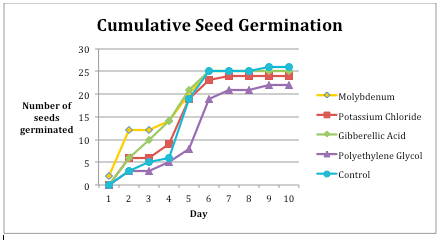Increasing soybean germination rate
Will seeds in various solutions known to affect germination actually increase the percentage of seeds germinated?
Supervising teacher
Mrs. Mullins
Student
Katie G and Sophia P
School
Turpin High School, Cincinnati, OH
Supporting files
final-paper-paul-and-gothard.pdf

Seed germination begins with the rupturing of the seed coat and the emergence of the radicle, which will form the first roots of the seedling. Molybdenum is a catalyst for several enzymatic reactions in a cell, and potassium chloride is an essential macronutrient for plants. Gibberellic acid stimulates cell division, and polyethylene glycol lowers osmotic potential of cells. The experiment tested the germination rate of soybean seeds in molybdenum, potassium chloride, gibberellic acid, polyethylene glycol, and distilled water solutions. The hypothesis was that if gibberellic acid stimulates cell division and decreases dormancy, then a higher percent of the soybean seeds in the gibberellic acid solution will germinate than in the other solutions. 48 soybean seeds were germinated on cotton pads soaked in each solution for ten days. A similar percentage of seeds in the molybdenum, potassium chloride, gibberellic acid, and distilled water solutions germinated by the end of the duration of the experiment. Fewer seeds in the polyethylene glycol solution germinated, and the radicles of the germinated seeds in the polyethylene glycol solution were significantly shorter than the radicles of the seeds germinated in other solutions. The radicles of the seeds in the potassium chloride solution were longer than the radicles of seeds in the other solutions.

There are many possibilities for future experimentation. With sufficient equipment to measure protein content, it would be interesting to measure the effect of these solutions on the protein content of the seeds grown in the solutions. Due to the widespread use of soybeans as sources of protein, increasing the protein content of soybeans would be very relevant to soybean production and marketing. Another possibility would be to test the effects of the solutions on the ability of the plants grown in different solutions to resist common plagues to soybeans, such as stinkbugs or soybean cyst nematodes.